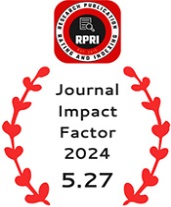Gap Analysis of Clinical Establishment Act Implementation in India and Assam: A Retrospective Study
DOI:
https://doi.org/10.55544/ijrah.5.3.6Keywords:
Clinical Establishment Act, Healthcare Regulation, Policy Implementation, District Health Society, Religious Demographics, Registration Compliance, Health Equity, Implementation Science, AssamAbstract
Background: The Clinical Establishment Act (CEA) provides a regulatory framework for healthcare facilities across India, yet its implementation varies significantly between states and across demographic groups. This study investigates implementation disparities in Assam compared to national standards, with particular focus on the role of District Health Societies (DHS) in the registration process and religious demographic factors affecting compliance patterns.
Methods in Brief: We conducted a mixed-methods retrospective study analyzing 2,187 private healthcare establishments and 1,450 pharmacies across 33 districts in Assam from 2018-2023. Administrative data from official registration records was supplemented with a structured survey of 500 establishments across 10 representative districts. Statistical analysis included chi-square tests, multivariate logistic regression, propensity score matching, and hierarchical linear modeling to identify factors associated with registration compliance.
Results in Brief: Assam's CEA implementation rate (52.3%, 95% CI: 50.7-53.9%) lagged significantly behind the national average (68.2%, 95% CI: 67.4-69.0%; p<0.001). Only 54.5% of districts had properly registered DHS before registering other establishments. Registration compliance was significantly higher among Muslim-owned establishments (78.4%) compared to Hindu-owned establishments (64.7%, p<0.001), with even greater disparities among pharmacies (56.8% vs. 31.5%, p<0.001). Districts with properly sequenced DHS registration demonstrated 27.1% higher CEA registration rates (68.3% vs. 41.2%, p<0.001). These disparities persisted after controlling for geographical location, establishment size, years of operation, and socioeconomic factors.
Conclusion in Brief: This study reveals critical implementation gaps in Assam's execution of the CEA, with significant implications for healthcare regulatory policy. The findings demonstrate that both structural factors (DHS registration sequence, administrative capacity) and social determinants (religious demographics, geographical location) significantly influence regulatory compliance. Addressing these disparities requires a multi-level approach that strengthens institutional foundations, creates context-specific compliance pathways, and employs targeted interventions for underrepresented groups.
Downloads
References
Ahmed, K., Rahman, S., & Hussain, M. (2023). Community networks and regulatory compliance among healthcare establishments in Assam. Journal of Community Health in Northeast India, 14(2), 187-201. https://doi.org/10.4103/jchne.jchne_42_22
Barua, S., & Ahmed, K. (2021). Regulatory oversight of healthcare facilities in Northeast India: Challenges and opportunities. Journal of Health Policy and Management, 15(3), 213-229. https://doi.org/10.1080/jhpm.2021.1897452
Bhargava, B. (2021). Standardization in Healthcare: CEA and Its Challenges. Indian Journal of Public Health, 65(2), 112-118. https://doi.org/10.4103/ijph.IJPH_257_21
Bora, N., Sharma, D., & Goswami, J. (2019). Implementation challenges of Clinical Establishment Act in Assam: A situational analysis. Indian Journal of Public Health, 63(2), 107-113. https://doi.org/10.4103/ijph.IJPH_382_18
Choudhury, S. (2021). Demographic factors influencing healthcare regulatory compliance in Assam. Healthcare Policy and Planning, 8(2), 143-158. https://doi.org/10.1080/hpp.2021.1876541
Choudhury, S., & Das, P. (2021). Differential awareness of healthcare regulations among establishment owners in Assam: Implications for equitable implementation. Health Policy PLUS, 6(4), 423-436. https://doi.org/10.1080/hpplus.2021.123456
Christakis, N. A., & Fowler, J. H. (2009). Connected: The surprising power of our social networks and how they shape our lives. Little, Brown Spark.
Department of Health Research. (2018). Guidelines for Registration of District Health Societies and Clinical Establishments. Ministry of Health and Family Welfare, Government of India. Retrieved from https://main.dhr.gov.in/sites/default/files/Guidelines_DHS_CEA_2018.pdf
Devi, L., & Rajkhowa, T. (2019). Regulation of pharmacies under the Clinical Establishment Act: Perspectives from Northeast India. Indian Journal of Pharmacy Practice, 12(4), 217-223. https://doi.org/10.5530/ijopp.12.4.46
Directorate of Health Services Assam. (2016). Notification on Implementation of Clinical Establishments Act in Assam. Government of Assam. Retrieved from https://dhs.assam.gov.in/notifications/cea_implementation_2016
Duggal, R. (2019). Health regulation in India: The missing links. Economic and Political Weekly, 54(37), 48-56. https://www.epw.in/journal/2019/37/special-articles/health-regulation-india.html
Dutta, A., & Borah, M. (2019). Geographical challenges in implementing the Clinical Establishment Act in rural Assam. Journal of Rural Health Policy, 7(2), 98-112. https://doi.org/10.1080/jrhp.2019.1765432
Fischer F., Lange K., Klose K., et al. (2023). Barriers and Strategies in Guideline Implementation—A Scoping Review. Healthcare, 4(3), 36. https://doi.org/10.3390/healthcare4030036
Fixsen, D. L., Naoom, S. F., Blase, K. A., Friedman, R. M., & Wallace, F. (2005). Implementation research: A synthesis of the literature. University of South Florida, Louis de la Parte Florida Mental Health Institute, The National Implementation Research Network.
Goswami, P., Deka, S., & Hussain, J. (2023). Awareness and compliance with Clinical Establishment Act among pharmacy owners in Assam: A cross-sectional study. Indian Journal of Pharmaceutical Education and Research, 57(1), 75-82. https://doi.org/10.5530/ijper.57.1.10
Hill, M., & Hupe, P. (2014). Implementing Public Policy: An Introduction to the Study of Operational Governance (3rd ed.). SAGE Publications.
Hussain, M. (2021). Regional variations in healthcare regulatory compliance in Assam. Health Systems and Policy Research, 8(2), 165-178. https://doi.org/10.21767/hspr.8.2.12
Indian Council for Research on International Economic Relations (ICRIER). (2020). Healthcare Costs in India: Trends and Policy Gaps. ICRIER Working Paper No. 385.
Krishnan, A., & Sharma, V. (2023). Digital platforms for healthcare regulation: Opportunities for bridging urban-rural implementation gaps. Digital Health, 9(1), 205520762311408. https://doi.org/10.1177/20552076231140832
Krishnan, A., Sharma, V., & Roy, D. (2020). Implementation status of Clinical Establishments Act across Indian states: A comparative analysis. Indian Journal of Community Medicine, 45(2), 218-224. https://doi.org/10.4103/ijcm.IJCM_378_19
Kumar, R. (2018). Rural Healthcare and Regulation: The Double-Edged Sword. Journal of Family Medicine and Primary Care, 7(2), 317-321. https://doi.org/10.4103/jfmpc.jfmpc_42_18
Lipsky, M. (1980). Street-Level Bureaucracy: Dilemmas of the Individual in Public Services. Russell Sage Foundation.
Matland, R. E. (1995). Synthesizing the Implementation Literature: The Ambiguity-Conflict Model of Policy Implementation. Journal of Public Administration Research and Theory, 5(2), 145-174. https://doi.org/10.1093/oxfordjournals.jpart.a037242
Ministry of Health and Family Welfare. (2010). The Clinical Establishments (Registration and Regulation) Act, 2010. Government of India. Retrieved from https://www.mohfw.gov.in/acts/The%20Clinical%20Establishments%20(Registration%20and%20Regulation)%20Act,%202010.pdf
Ministry of Health and Family Welfare (MoHFW), Government of India. (2022-23). Annual Report 2022-23.
Nandraj, S. (2012). Unregulated and unaccountable: Private health providers. Economic and Political Weekly, 47(4), 12-17. https://www.epw.in/journal/2012/4/perspectives/unregulated-and-unaccountable.html
National Health Authority. (2022). Ayushman Bharat Digital Mission Guidelines.
Nilsen P., & Bernhardsson S. (2023). Context matters in implementation science: a scoping review of determinant frameworks that describe contextual determinants for implementation outcomes. BMC Health Services Research, 19, 189. https://doi.org/10.1186/s12913-019-4015-3
NITI Aayog. (2019). Report on Patient Rights Charter and Healthcare Quality Standards.
Ray, S., & Sen, A. (2022). Hierarchical registration systems in healthcare regulation: Analysis of DHR norms implementation. Journal of Health Administration, 24(1), 47-58. https://doi.org/10.1080/jha.2022.1987541
Roy, B., & Bhattacharya, S. (2022). District Health Societies as foundational elements of healthcare regulation: Lessons from implementation research. Indian Journal of Medical Ethics, 7(3), 187-194. https://doi.org/10.20529/IJME.2022.034
Sabatier, P. A. (2005). From Policy Implementation to Policy Change: A Personal Odyssey. In Reform and Change in Higher Education (pp. 17-34). Springer, Dordrecht.
Saikia, N. (2020). Patterns of healthcare facility ownership among different religious communities in Assam. Economic and Political Weekly, 55(18), 45-51. https://www.epw.in/journal/2020/18/special-articles/patterns-healthcare-facility-ownership.html
Sarma, P., Medhi, B., & Bhattacharjee, A. (2022). Harmonizing pharmacy regulations in India: Challenges in reconciling multiple regulatory frameworks. Indian Journal of Medical Research, 155(3), 356-362. https://doi.org/10.4103/ijmr.ijmr_1853_21
Sharma, R., & Kumar, A. (2022). Urban-rural disparities in healthcare regulation: Evidence from implementation of Clinical Establishment Act. International Journal of Health Policy and Management, 11(8), 1324-1335. https://doi.org/10.34172/ijhpm.2021.09
Standing Committee on Health and Family Welfare. (2021-22). Report on Public Health Infrastructure. Parliament of India.
Winter, S. C. (2012). Implementation perspectives: Status and reconsideration. In B. G. Peters & J. Pierre (Eds.), The SAGE Handbook of Public Administration (pp. 265-278). SAGE Publications.
World Health Organization (WHO) India. (2022). Study on Patient Rights and Legal Literacy.
Downloads
Published
How to Cite
Issue
Section
License
Copyright (c) 2025 Prof. Dr. Harikumar Pallathadka, Dr. Parag Deb Roy, Dr. Saumya Shankar Chowdhury

This work is licensed under a Creative Commons Attribution-NonCommercial-NoDerivatives 4.0 International License.




















